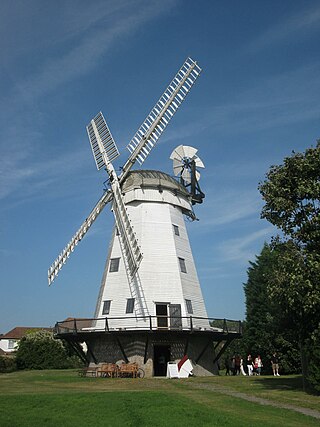
Upminster Windmill is a Grade II* listed smock mill located in Upminster in the London Borough of Havering, England. It was formerly known as Abraham's Mill and was in Essex when built. It has been restored and is a museum open to the public at selected times.
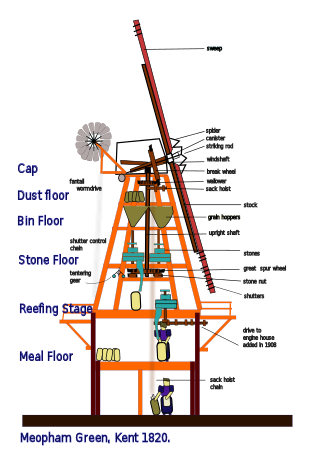
This glossary of mill machinery covers the major pieces of machinery to be found in windmills, watermills and horse mills. It does not cover machinery found in modern factories.

Union Mill is a Grade I listed smock mill in Cranbrook, Kent, England, which has been restored to working order. It is the tallest smock mill in the United Kingdom.
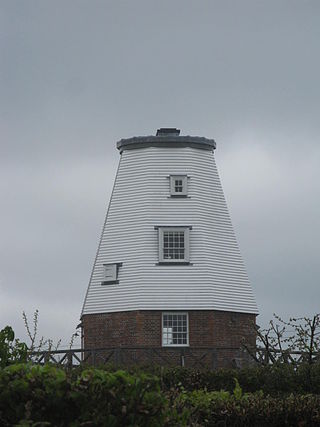
Beacon Mill is a Grade II listed smock mill in Benenden, Kent, England which is in need of restoration. The mill has been out of use since 1923 and is privately owned.

Charing Windmill is a Grade II listed smock windmill, now converted to a house, on Charing Hill in Kent in southeast England. It is sometimes known as Field Mill, but that name was also used by a watermill in Charing.
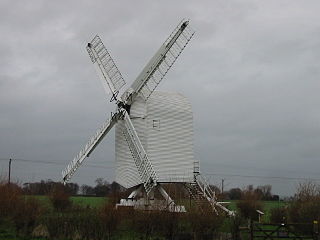
Chillenden windmill is a grade II* listed open-trestle post mill north of Chillenden, Kent, England. It is the last post mill built in Kent.

Reigate Heath Windmill is a grade II* listed post mill at Reigate Heath, Surrey, England which has been restored and is used as a chapel. It is thought to be the only windmill in the world which is a consecrated church.

Shiremark Mill, also known as Kingsfold Mill or Capel Mill was a listed Smock mill at Capel, Surrey, England, which was burnt down in 1972.

Barnet Gate Mill or Arkley Windmill is a grade II* listed tower mill at Barnet Gate in the London Borough of Barnet, originally in Hertfordshire. There is no public access.

Bocking Windmill or Bocking Churchstreet Windmill is a grade I listed post mill at Bocking, Essex, England which has been restored.

Bardwell Mill is a Grade II* listed tower mill at Bardwell, Suffolk, England, which is under restoration.

Thelnetham Windmill, also known as Button's Mill is a Grade II* listed tower mill constructed of brick. The windmill is located at Thelnetham, Suffolk, England. It was built in the early nineteenth century to grind wheat into flour. Thelnetham windmill worked by wind power until 1924, latterly on two sails, after which it became derelict.
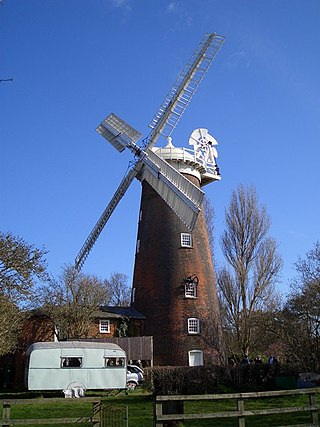
Buttrum's Mill or Trott's Mill is a Grade II* listed tower mill at Woodbridge, Suffolk, England, which has been restored to working order.

Garboldisham Mill is a Grade II* listed post mill at Garboldisham, Norfolk, that has been restored.

Terpzigt is a drainage mill in Marssum, Friesland, Netherlands. It is the smallest spinnenkop, a type of hollow post windmill. The mill is listed as a Rijksmonument, number 8625.
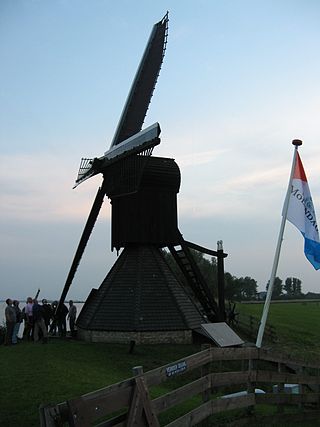
Doris Mooltsje is a drainage mill near the village of Oudega, Friesland, Netherlands. It is a hollow post windmill of the type called spinnenkop by the Dutch. The mill is listed as a Rijksmonument, number 527647 and has been restored to working order in 1998.

Teetlum, after a nearby terp, also known as Duivenhok 'dove coat' named after the polder it drained, is a drainage mill near the village of Tzum, Friesland, Netherlands. It is a hollow post windmill of the type called spinnenkop by the Dutch. The mill is listed as a Rijksmonument, number 15877 and can be used to drain the adjacent polder.

The smock mill at the Netherlands Open Air Museum, Arnhem, Gelderland, Netherlands was originally built at Noordlaren, Groningen, Netherlands in 1862. It was dismantled in 1953 and re-erected at the museum in 1960. The mill has been restored to working order.

A hollow post mill at the Netherlands Open Air Museum, Arnhem, Gelderland, Netherlands was originally built at Gouda, South Holland, Netherlands. It was dismantled in 1946 and re-erected at the museum. The mill has been restored to working order.




















